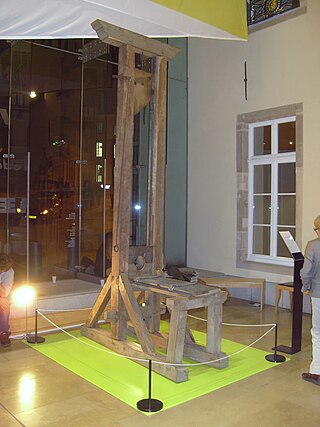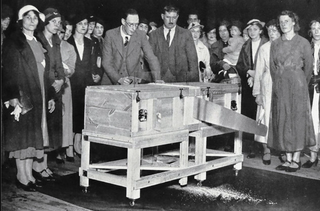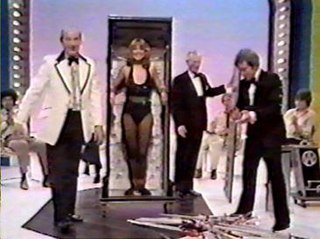
A guillotine is an apparatus designed for efficiently carrying out executions by beheading. The device consists of a tall, upright frame with a weighted and angled blade suspended at the top. The condemned person is secured with a pillory at the bottom of the frame, holding the position of the neck directly below the blade. The blade is then released, swiftly and forcefully decapitating the victim with a single, clean pass; the head falls into a basket or other receptacle below.

The cups and balls is a performance of magic with innumerable adaptations. Street gambling variations performed by conmen were known as Bunco Booths. A typical cups and balls routine includes many of the most fundamental effects of magic: the balls can vanish, appear, transpose, reappear and transform. Basic skills, such as misdirection, manual dexterity, sleight of hand, and audience management are also essential to most cups and balls routines. As a result, mastery of the cups and balls is considered by many as the litmus test of a magician's skill with gimmick style tricks. Magician John Mulholland wrote that Harry Houdini had expressed the opinion that no one could be considered an accomplished magician until he had mastered the cups and balls. Professor Hoffman called the cups and balls "the groundwork of all legerdemain".

Sawing a woman in half is a generic name for a number of stage magic tricks in which a person is apparently cut or divided into two or more pieces.

Harry Bouton Blackstone was a famed stage magician and illusionist of the 20th century. Blackstone was born Harry Bouton in Chicago, Illinois. He began his career as a magician in his teens and was popular through World War II as a USO entertainer. He was often billed as The Great Blackstone. His son Harry Blackstone Jr. also became a famous magician. Blackstone Sr. was aided by his younger brother, Pete Bouton, who was the stage manager in all his shows. Blackstone Sr. was married three times. Blackstone Jr. was his son by his second wife.

Street magic falls into two genres; traditional street performance and guerrilla magic.
The Mismade Girl is a stage illusion, designed by American magician Chuck Jones. It is a variation of the sawing a woman in half illusion.
The Zig-Zag Girl illusion is a stage illusion akin to the more famous sawing a woman in half illusion. In the Zig-Zag illusion, a magician divides an assistant into thirds, only to have them emerge from the illusion at the end of the performance completely unharmed.
This timeline of magic is a history of the performing art from B.C. to the present.

Jim Steinmeyer is an American author, inventor, and designer of magical illusions and theatrical special effects. He holds four US patents in the field of illusion apparatus, including a modern version of the Pepper's Ghost illusion. Steinmeyer has consulted for many famous magicians, including David Copperfield, Doug Henning, Siegfried and Roy, and Lance Burton.

Magicians is a 2007 British comedy film released on 18 May 2007. It stars comic duo Robert Webb and David Mitchell as stage magicians Karl and Harry. The two magicians compete together in a magic competition, despite their personal differences. Parts and ideas of the film have been taken to parody the 2006 film The Prestige by Christopher Nolan, though this had not been released when Magicians was filmed. The film is directed by Andrew O'Connor and written by Jesse Armstrong and Sam Bain, who are also the writers of the Channel 4 sitcom Peep Show, which stars Mitchell and Webb. Other principal cast members include Jessica Hynes, Darren Boyd, Steve Edge, Peter Capaldi, and Andrea Riseborough.

The Aztec Lady is a stage illusion designed by British magician Robert Harbin. It is a classic "big box" illusion that involves an assistant in a cabinet and is probably best categorised as a restoration-type illusion.

The Radium Girl is a stage illusion of the classic type involving a female assistant in a large box and is probably best categorised as a penetration or restoration-type illusion. Its origins and history are much less well documented than those of many other "big box" illusions but some sources indicate it might be one of the earliest examples of that type of trick. References and picture captions indicate it was the creation of British magician and designer Val Walker.
The table of death is a predicament escape that may be regarded as a magic trick or an act of escapology.

The Discoverie of Witchcraft is a partially sceptical book published by the English gentleman Reginald Scot in 1584, intended as an exposé of early modern witchcraft. It contains a small section intended to show how the public was fooled by charlatans, which is considered the first published material on illusionary or stage magic.

The Drill of Death is a large-scale stage illusion in which a performer appears to be impaled on a giant drill. It was created by magician André Kole and illusion designer Ken Whitaker for magician Melinda Saxe. It was one of Saxe's signature tricks and featured as a highlight in her various First Lady of Magic shows.

Magic, which encompasses the subgenres of illusion, stage magic, and close up magic, among others, is a performing art in which audiences are entertained by tricks, effects, or illusions of seemingly impossible feats, using natural means. It is to be distinguished from paranormal magic which are effects claimed to be created through supernatural means. It is one of the oldest performing arts in the world.
The Inexhaustible Bottle is a classic magic trick performed by stage magicians. It dates to the 17th century and has since inspired many variations; well known examples include Any Drink Called For, The Bar Act, Satan's Barman, the Assassin's Teapot and Think-a-Drink. During the temperance movement it became The Obliging Tea Kettle, and the modern Magic Tea Kettle remains a common prop available at most magic stores. A slight variation is the Magic Funnel. Today, the trick is normally performed for children, although some stand-up shows retain a variation.
The blow book, better known as a magic coloring book in modern variations, is a classic magic trick that has been performed for hundreds of years. It was most popular from the 16th to the 19th century, when variations of the concept were a staple of the book publishing trade. It has been referred to as the oldest example of a manufactured prop used for magic. It remains a common trick today, albeit mostly performed for children, preferably at birthday parties or other events due to the visual nature of the illusion.

A levitation illusion is one in which a magician appears to defy gravity by making an object or person float in the air. The subject may appear to levitate unassisted, or it may be performed with the aid of another object in which case it is termed a "suspension".
Joseph Vanek was a Hungarian magician and scientist. He became well known for an illusion that involved the decapitation of his son, the head was even passed to the audience.












